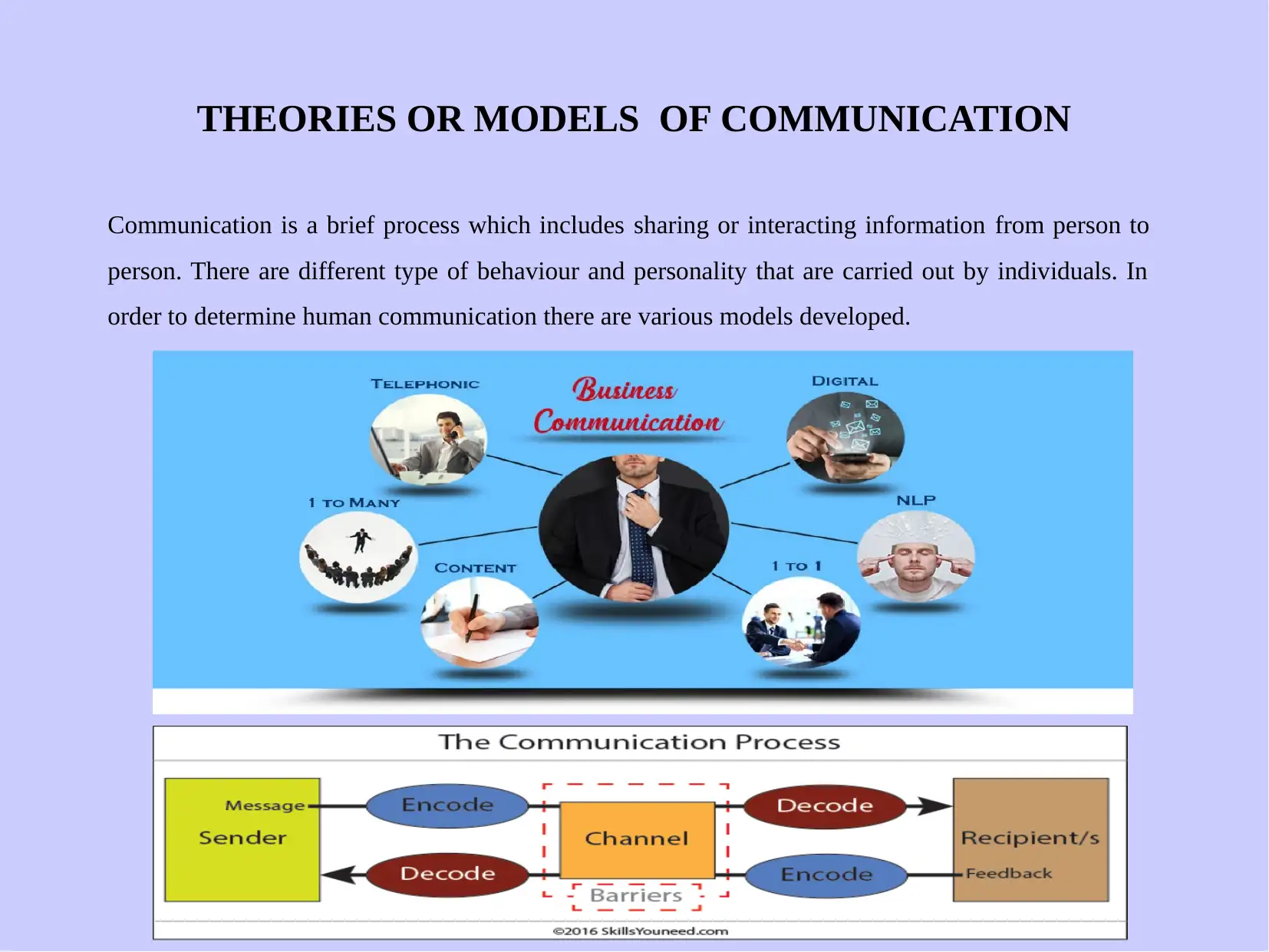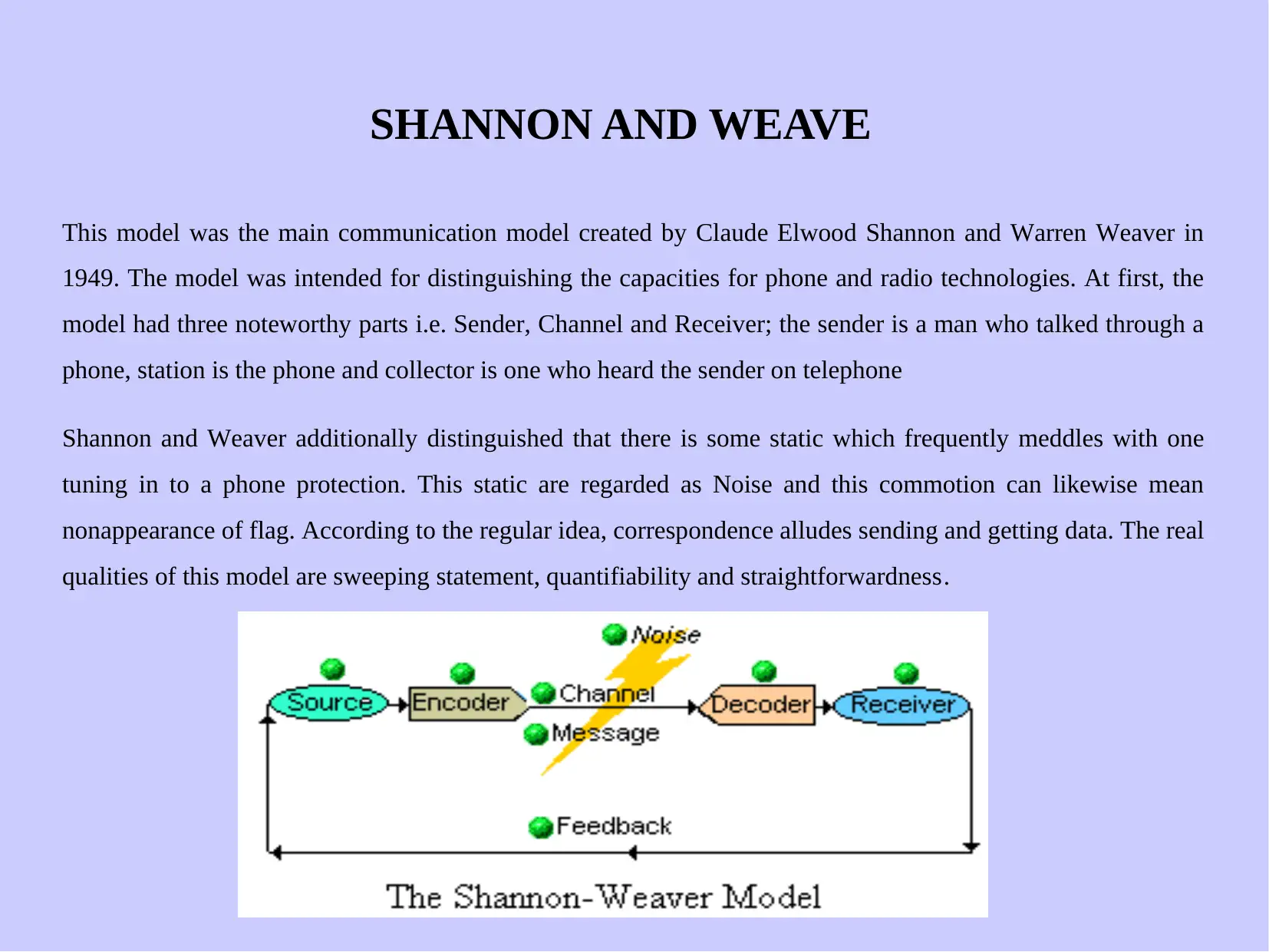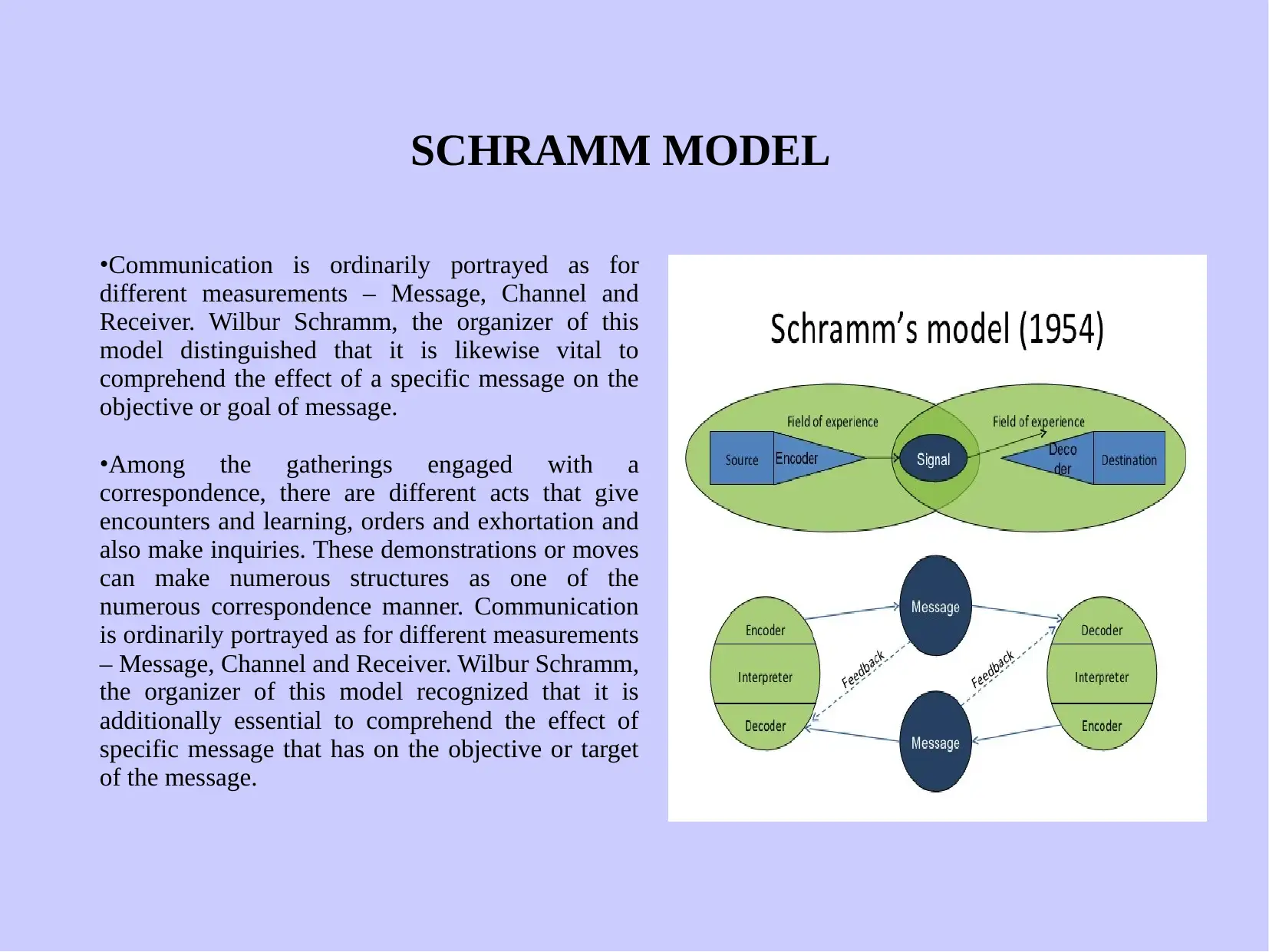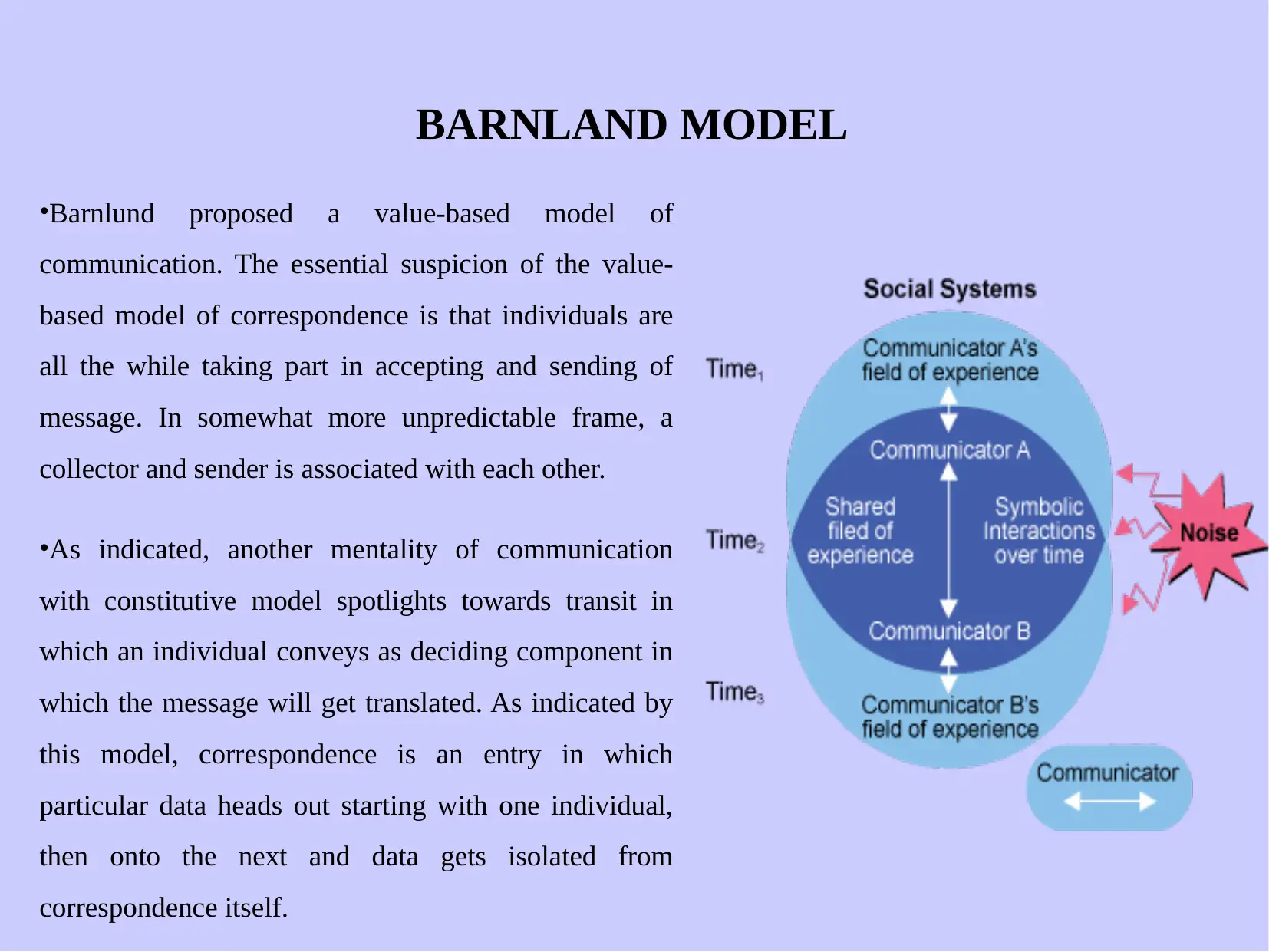Unit 3.26: Communication Skills for Business Models Report
VerifiedAdded on 2023/02/03
|6
|618
|48
Report
AI Summary
This report provides an overview of communication models relevant to business communication. It details the Shannon and Weaver model, highlighting its components of sender, channel, and receiver, and emphasizing the concept of noise. The report also examines the Schramm model, focusing on the importance of understanding the impact of a message on its target audience. Furthermore, it delves into the Barnlund model, which emphasizes the transactional nature of communication, where individuals simultaneously send and receive messages. The report includes references to academic sources and concludes with a thank you.

THEORIES OR MODELS OF COMMUNICATION
Communication is a brief process which includes sharing or interacting information from person to
person. There are different type of behaviour and personality that are carried out by individuals. In
order to determine human communication there are various models developed.
Communication is a brief process which includes sharing or interacting information from person to
person. There are different type of behaviour and personality that are carried out by individuals. In
order to determine human communication there are various models developed.
Paraphrase This Document
Need a fresh take? Get an instant paraphrase of this document with our AI Paraphraser

SHANNON AND WEAVE
This model was the main communication model created by Claude Elwood Shannon and Warren Weaver in
1949. The model was intended for distinguishing the capacities for phone and radio technologies. At first, the
model had three noteworthy parts i.e. Sender, Channel and Receiver; the sender is a man who talked through a
phone, station is the phone and collector is one who heard the sender on telephone
Shannon and Weaver additionally distinguished that there is some static which frequently meddles with one
tuning in to a phone protection. This static are regarded as Noise and this commotion can likewise mean
nonappearance of flag. According to the regular idea, correspondence alludes sending and getting data. The real
qualities of this model are sweeping statement, quantifiability and straightforwardness.
This model was the main communication model created by Claude Elwood Shannon and Warren Weaver in
1949. The model was intended for distinguishing the capacities for phone and radio technologies. At first, the
model had three noteworthy parts i.e. Sender, Channel and Receiver; the sender is a man who talked through a
phone, station is the phone and collector is one who heard the sender on telephone
Shannon and Weaver additionally distinguished that there is some static which frequently meddles with one
tuning in to a phone protection. This static are regarded as Noise and this commotion can likewise mean
nonappearance of flag. According to the regular idea, correspondence alludes sending and getting data. The real
qualities of this model are sweeping statement, quantifiability and straightforwardness.

SCHRAMM MODEL
•Communication is ordinarily portrayed as for
different measurements – Message, Channel and
Receiver. Wilbur Schramm, the organizer of this
model distinguished that it is likewise vital to
comprehend the effect of a specific message on the
objective or goal of message.
•Among the gatherings engaged with a
correspondence, there are different acts that give
encounters and learning, orders and exhortation and
also make inquiries. These demonstrations or moves
can make numerous structures as one of the
numerous correspondence manner. Communication
is ordinarily portrayed as for different measurements
– Message, Channel and Receiver. Wilbur Schramm,
the organizer of this model recognized that it is
additionally essential to comprehend the effect of
specific message that has on the objective or target
of the message.
•Communication is ordinarily portrayed as for
different measurements – Message, Channel and
Receiver. Wilbur Schramm, the organizer of this
model distinguished that it is likewise vital to
comprehend the effect of a specific message on the
objective or goal of message.
•Among the gatherings engaged with a
correspondence, there are different acts that give
encounters and learning, orders and exhortation and
also make inquiries. These demonstrations or moves
can make numerous structures as one of the
numerous correspondence manner. Communication
is ordinarily portrayed as for different measurements
– Message, Channel and Receiver. Wilbur Schramm,
the organizer of this model recognized that it is
additionally essential to comprehend the effect of
specific message that has on the objective or target
of the message.
⊘ This is a preview!⊘
Do you want full access?
Subscribe today to unlock all pages.

Trusted by 1+ million students worldwide

BARNLAND MODEL
•Barnlund proposed a value-based model of
communication. The essential suspicion of the value-
based model of correspondence is that individuals are
all the while taking part in accepting and sending of
message. In somewhat more unpredictable frame, a
collector and sender is associated with each other.
•As indicated, another mentality of communication
with constitutive model spotlights towards transit in
which an individual conveys as deciding component in
which the message will get translated. As indicated by
this model, correspondence is an entry in which
particular data heads out starting with one individual,
then onto the next and data gets isolated from
correspondence itself.
•Barnlund proposed a value-based model of
communication. The essential suspicion of the value-
based model of correspondence is that individuals are
all the while taking part in accepting and sending of
message. In somewhat more unpredictable frame, a
collector and sender is associated with each other.
•As indicated, another mentality of communication
with constitutive model spotlights towards transit in
which an individual conveys as deciding component in
which the message will get translated. As indicated by
this model, correspondence is an entry in which
particular data heads out starting with one individual,
then onto the next and data gets isolated from
correspondence itself.
Paraphrase This Document
Need a fresh take? Get an instant paraphrase of this document with our AI Paraphraser

REFERENCES
McQuail, D. and Windahl, S., 2015. Communication models for the study of mass
communications. Routledge.
Hiller, A., Guillemin, M. and Delany, C., 2015. Exploring healthcare
communication models in private physiotherapy practice. Patient education and
counseling, 98(10), pp.1222-1228.
Wuyts, W.A., Peccatori, F.A. and Russell, A.M., 2014. Patient-centred management
in idiopathic pulmonary fibrosis: similar themes in three communication
models. European Respiratory Review, 23(132), pp.231-238.
Paun, G., Rozenberg, G. and Salomaa, A., 2010. The Oxford handbook of
membrane computing. Oxford University Press, Inc.
Bruneel, H. and Kim, B.G., 2012. Discrete-time models for communication systems
including ATM (Vol. 205). Springer Science & Business Media.
Sharifian, F. and Jamarani, M. eds., 2013. Language and intercultural
communication in the new era. Routledge.
McQuail, D. and Windahl, S., 2015. Communication models for the study of mass
communications. Routledge.
Hiller, A., Guillemin, M. and Delany, C., 2015. Exploring healthcare
communication models in private physiotherapy practice. Patient education and
counseling, 98(10), pp.1222-1228.
Wuyts, W.A., Peccatori, F.A. and Russell, A.M., 2014. Patient-centred management
in idiopathic pulmonary fibrosis: similar themes in three communication
models. European Respiratory Review, 23(132), pp.231-238.
Paun, G., Rozenberg, G. and Salomaa, A., 2010. The Oxford handbook of
membrane computing. Oxford University Press, Inc.
Bruneel, H. and Kim, B.G., 2012. Discrete-time models for communication systems
including ATM (Vol. 205). Springer Science & Business Media.
Sharifian, F. and Jamarani, M. eds., 2013. Language and intercultural
communication in the new era. Routledge.

THANK YOU!!
⊘ This is a preview!⊘
Do you want full access?
Subscribe today to unlock all pages.

Trusted by 1+ million students worldwide
1 out of 6
Related Documents
Your All-in-One AI-Powered Toolkit for Academic Success.
+13062052269
info@desklib.com
Available 24*7 on WhatsApp / Email
![[object Object]](/_next/static/media/star-bottom.7253800d.svg)
Unlock your academic potential
Copyright © 2020–2025 A2Z Services. All Rights Reserved. Developed and managed by ZUCOL.





